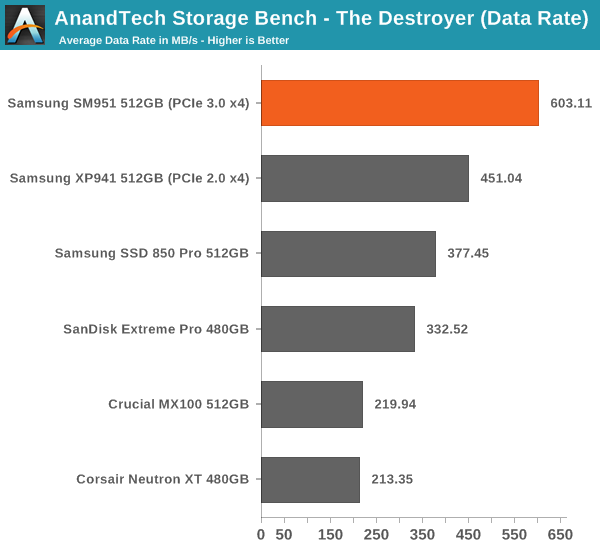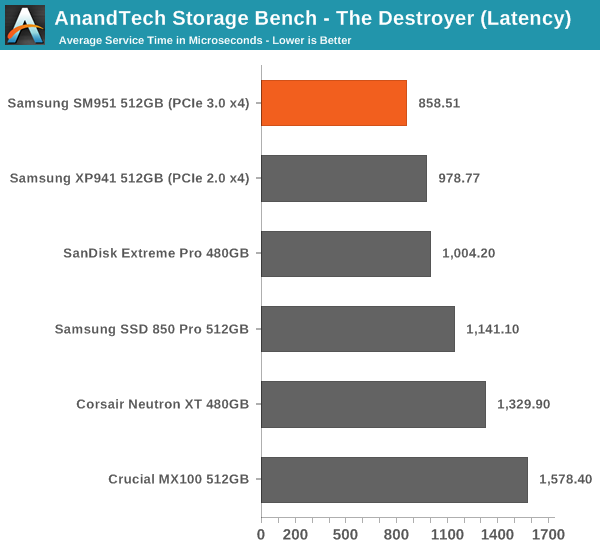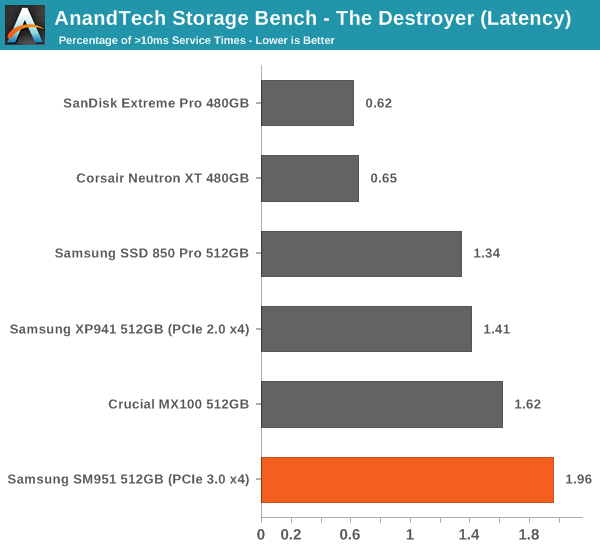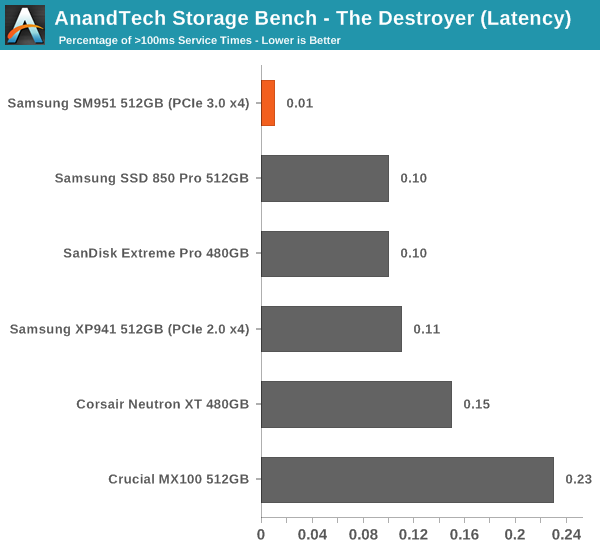Samsung SM951 (512GB) PCIe SSD Review
by Kristian Vättö on February 24, 2015 8:00 AM ESTAnandTech Storage Bench - The Destroyer
The Destroyer has been an essential part of our SSD test suite for nearly two years now. It was crafted to provide a benchmark for very IO intensive workloads, which is where you most often notice the difference between drives. It's not necessarily the most relevant test to an average user, but for anyone with a heavier IO workload The Destroyer should do a good job at characterizing performance.
| AnandTech Storage Bench - The Destroyer | ||||||||||||
| Workload | Description | Applications Used | ||||||||||
| Photo Sync/Editing | Import images, edit, export | Adobe Photoshop CS6, Adobe Lightroom 4, Dropbox | ||||||||||
| Gaming | Download/install games, play games | Steam, Deus Ex, Skyrim, Starcraft 2, BioShock Infinite | ||||||||||
| Virtualization | Run/manage VM, use general apps inside VM | VirtualBox | ||||||||||
| General Productivity | Browse the web, manage local email, copy files, encrypt/decrypt files, backup system, download content, virus/malware scan | Chrome, IE10, Outlook, Windows 8, AxCrypt, uTorrent, AdAware | ||||||||||
| Video Playback | Copy and watch movies | Windows 8 | ||||||||||
| Application Development | Compile projects, check out code, download code samples | Visual Studio 2012 | ||||||||||
The table above describes the workloads of The Destroyer in a bit more detail. Most of the workloads are run independently in the trace, but obviously there are various operations (such as backups) in the background.
| AnandTech Storage Bench - The Destroyer - Specs | ||||||||||||
| Reads | 38.83 million | |||||||||||
| Writes | 10.98 million | |||||||||||
| Total IO Operations | 49.8 million | |||||||||||
| Total GB Read | 1583.02 GB | |||||||||||
| Total GB Written | 875.62 GB | |||||||||||
| Average Queue Depth | ~5.5 | |||||||||||
| Focus | Worst case multitasking, IO consistency | |||||||||||
The name Destroyer comes from the sheer fact that the trace contains nearly 50 million IO operations. That's enough IO operations to effectively put the drive into steady-state and give an idea of the performance in worst case multitasking scenarios. About 67% of the IOs are sequential in nature with the rest ranging from pseudo-random to fully random.
| AnandTech Storage Bench - The Destroyer - IO Breakdown | |||||||||||
| IO Size | <4KB | 4KB | 8KB | 16KB | 32KB | 64KB | 128KB | ||||
| % of Total | 6.0% | 26.2% | 3.1% | 2.4% | 1.7% | 38.4% | 18.0% | ||||
I've included a breakdown of the IOs in the table above, which accounts for 95.8% of total IOs in the trace. The leftover IO sizes are relatively rare in between sizes that don't have a significant (>1%) share on their own. Over a half of the transfers are large IOs with one fourth being 4KB in size.
| AnandTech Storage Bench - The Destroyer - QD Breakdown | ||||||||||||
| Queue Depth | 1 | 2 | 3 | 4-5 | 6-10 | 11-20 | 21-32 | >32 | ||||
| % of Total | 50.0% | 21.9% | 4.1% | 5.7% | 8.8% | 6.0% | 2.1% | 1.4 | ||||
Despite the average queue depth of 5.5, a half of the IOs happen at queue depth of one and scenarios where the queue depths is higher than 10 are rather infrequent.
The two key metrics I'm reporting haven't changed and I'll continue to report both data rate and latency because the two have slightly different focuses. Data rate measures the speed of the data transfer, so it emphasizes large IOs that simply account for a much larger share when looking at the total amount of data. Latency, on the other hand, ignores the IO size, so all IOs are given the same weight in the calculation. Both metrics are useful, although in terms of system responsiveness I think the latency is more critical. As a result, I'm also reporting two new stats that provide us a very good insight to high latency IOs by reporting the share of >10ms and >100ms IOs as a percentage of the total.

The SM951 takes the lead easily and provides ~34% increase in data rate over the XP941. The advantage over some of the slower SATA 6Gbps drives is nearly threefold, which speaks for the performance benefit that PCIe and especially PCIe 3.0 provide.

The latency benefit isn't as significant, which suggests that the SM951 provides substantial boost in large IO performance, but the performance at small IO sizes isn't dramatically better.

Despite the lowest average latency, the SM951 actually has the most >10ms IO with nearly 2% of the IOs having higher latency than 10ms. I did some thermal throttling testing (see the dedicated page for full results) and the SM951 seems to throttle fairly aggressively, so my hypothesis is that the high number is due to throttling, which limits the drive's throughput momentarily (and hence increases the latency) to cool down the drive.

However, the SM951 has the least >100ms IOs, which means that despite the possible throttling the maximum service times stay between 10ms and 100ms.










128 Comments
View All Comments
Kristian Vättö - Sunday, March 1, 2015 - link
The 840 EVO issue takes weeks, even months to show up, so testing it is not something that we can really incorporate in our test suite.The read speed depends on the test you use and its specifications. The figures are always "up to" and tend to be based on high queue depth 128KB sequential read performance. You may want to try multiple benchmarking apps, but especially ATTO tends to show high performance since it tests multiple IO sizes.
And yes, we run the SSD as a secondary drive to eliminate any OS overhead.
MFinn3333 - Saturday, February 28, 2015 - link
Is there any way you can review the Fujitsu FSX 240GB? It's an old drive but it is the only consumer level drive that I am aware of that uses entirely SLC?Kristian Vättö - Sunday, March 1, 2015 - link
At least for now it's not in the review queue, but I will keep it in mind in case I have excess time.kenshinco - Monday, March 2, 2015 - link
How can we get the sm951 to runs up to the rated speed? The rated speed for 512gb is 2.15gbs/1550mbs read/write, but i got only 1560mbs/1570mbs read/write. I got temp monitor never pass 75 when testing.Kristian Vättö - Monday, March 2, 2015 - link
I was able to achieve 2250MB/s with 128KB sequential read (QD32) on an empty drive, which is how the read performance has been rated. That's not a realistic bench, though, because in reality you will never be reading from an empty drive.Gonemad - Thursday, March 5, 2015 - link
No word on Novachips 8TB SSD yet?http://www.theregister.co.uk/2015/03/05/eight_tera...
CallsignVega - Friday, March 6, 2015 - link
I just purchased the SM951 from the UK (512GB for $450). They are out there, you just have to know where to look.vegipiniata - Wednesday, March 11, 2015 - link
I got one SM951 512GB for 340£They were gone later that day.
Have Z97 Extreme9 and can't set it as the boot drive though :(
Bios 1.3 from DEC 2014
any chance it's the BIOS fault (too old)?
Stas - Friday, March 13, 2015 - link
There we go. Finally an incentive to upgrade from 2500k to a new platform. Once mobos with M.2 and NVM hit the market in Summer/Fall, I will be retiring the faithful rig.Edgar_in_Indy - Friday, March 13, 2015 - link
The 2500k is too good to retire!When I upgraded my main system a few weeks ago, I recycled my old 2500k and the board for use in a living room HTPC build that can handle 4K video files and do some gaming, all while running Windows Media Center with 5 ATSC tuners.